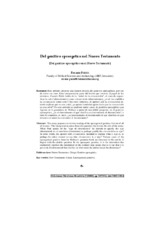Del genitivo epesegetico nel Nuovo Testamento
Del genitivo epexegético en el Nuevo Testamento

Ver/
Autor
Pierri, Rosario
Editor
Universidad de Córdoba, Servicio de PublicacionesFecha
2010Materia
Nuevo TestamentoGriego
Genitivo epexegético
New Testament
Greek
Epexegetical genitive
METS:
Mostrar el registro METSPREMIS:
Mostrar el registro PREMISMetadatos
Mostrar el registro completo del ítemResumen
Este artículo propone una lectura inversa del genitivo epexegético, pero no
de todos sus usos. Esta interpretación parte del hecho que invierte el papel de los
términos. Cuando Pablo habla de la “señal de la circuncisión”, el trata de especificar
la señal (determinado) como circuncisión (determinante), ¿o tal vez cualifica
la circuncisión como señal? En otros términos, el apóstol con la circuncisión intentó
explicar qué es una señal, ¿o quizás (también) quiso decir que la circuncisión
es una señal? En este artículo se analizan varios casos de genitivo epexegético que
figuran en la garmática de Wallace a partir de una doble pregunta: en el genitivo
epexegético, ¿es el determinante el que clarifica exclusivamente al determinado?, o
todo lo contrario, es decir, ¿es precisamente el determinado el que clarifica en qué
términos el autor da a entender el determinante? This essay proposes an inverse reading of the epexegetical genitive, but not of all
of its uses. This interpretation arises from the question that inverts the role of the terms.
When Paul speaks of the “sign of circumcision” he intends to specify the sign
(determined) as circumcision (determiner) or perhaps qualify the circumcision as sign?
In other words, the apostle with circumcision intended to explain what a sign is, or
perhaps he (also) wanted to say that circumcision is a sign? Various cases of the
epexegetical genitive found in Wallace’s grammar book are discussed in this article. It
begins with the double question: In the epexegetic genitive, it is the determiner that
exclusively clarifies the determined or the contrary may occur, that is to say that it is
precisely the determined that clarifies in what terms the author meant the determiner?
